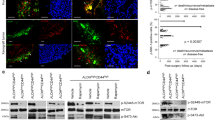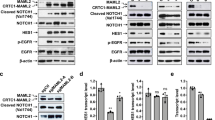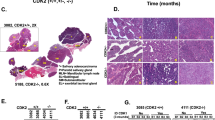Abstract
Mucoepidermoid (MEC) salivary gland tumors arise from a t(11;19) rearrangement which generates a fusion oncogene, Mect1-Maml2, that functions to activate CREB-responsive target genes. To determine if sustained expression of Mect1-Maml2 is required for tumor cell growth, we first showed that ectopic expression of Mect1-Maml2 in rat epithelial RK3E cells is tumorigenic in vivo in nude mice and that excised xenografts continue to express the fusion oncogene. We then generated a hairpin RNAi vector that selectively suppressed the fusion peptide and showed that ectopic expression in either parotid or pulmonary MEC tumor cell lines containing the t(11;19) rearrangement resulted in at least 90% colony growth inhibition. In contrast, single nucleotide changes within this RNAi sequence abolished the ability to suppress Mect1-Maml2 protein and abolished all growth inhibition of these MEC tumor lines. In addition, the RNAi-specific vector had no effect on colony growth of non-MEC tumors including a lung tumor or two other salivary gland cell lines that do not express Mect1-Maml2. We also generated a mutant Mect1-Maml2 expression plasmid that carried silent nucleotide changes within the RNAi target sequence and observed that co-transfection of this mutant, but not wild-type Mect1-Maml2, could partially rescue RNAi growth inhibition in the MEC tumor line. The recent detection of acquired fusion oncogenes in epithelial solid tumors has suggested new possibilities for the diagnosis and therapy of these cancers. Our data show that the ‘gain-of-function’ activity from aberrant Mect1-Maml2 expression is a candidate therapeutic target for this group of malignant salivary gland tumors.
This is a preview of subscription content, access via your institution
Access options
Subscribe to this journal
Receive 50 print issues and online access
$259.00 per year
only $5.18 per issue
Buy this article
- Purchase on Springer Link
- Instant access to full article PDF
Prices may be subject to local taxes which are calculated during checkout




Similar content being viewed by others
References
Behboudi A, Winnes M, Gorunova L, van den Oord JJ, Mertens F, Enlund F et al. (2005). Genes Chromosomes Cancer 43: 202–205.
Cho-Chung YS . (2003). Ann NY Acad Sci 1002: 124–133.
Conkright MD, Canettieri G, Screaton R, Guzman E, Miraglia L, Hogenesch JB et al. (2003). Mol Cell 12: 413–423.
Coxon A, Rozenblum E, Park YS, Joshi N, Tsurutani J, Dennis PA et al. (2005). Cancer Res 65: 7137–7144.
El-Naggar AK, Lovell M, Killary AM, Clayman GL, Batsakis JG . (1996). Cancer Genet Cytogenet 87: 29–33.
Enlund F, Behboudi A, Andren Y, Oberg C, Lendahl U, Mark J et al. (2004a). Exp Cell Res 292: 21–28.
Enlund F, Persson F, Stenman G . (2004b). Eur J Oral Sci 112: 545–547.
Grenman R, Pekkola-Heino K, Joensuu H, Aitasalo K, Klemi P, Lakkala T . (1992). Arch Otolaryngol Head Neck Surg 118: 542–547.
Iourgenko V, Zhang W, Mickanin C, Daly I, Jiang C, Hexham JM et al. (2003). Proc Natl Acad Sci USA 100: 12147–12152.
Lin SE, Oyama T, Nagase T, Harigaya K, Kitagawa M . (2002). J Biol Chem 277: 50612–50620.
Martins C, Cavaco B, Tonon G, Kaye FJ, Soares J, Fonseca I . (2004). J Mol Diagn 6: 205–210.
Mitelman F, Johansson B, Mertens F . (2004). Nat Genet 36: 331–334.
Roberts Jr TG, Barry M, Skarin AT . (2003). Clin Adv Hematol Oncol 1: 486–487.
Speight PM, Barrett AW . (2002). Oral Dis 8: 229–240.
Stenman G, Petursdottir V, Mellgren G, Mark J . (1998). Virchows Arch 433: 579–581.
Tognon C, Knezevich SR, Huntsman D, Roskelley CD, Melnyk N, Mathers JA et al. (2002). Cancer Cell 2: 367–376.
Tomlins SA, Rhodes DR, Perner S, Dhanasekaran SM, Mehra R, Sun XW et al. (2005). Science 310: 644–648.
Tonon G, Modi S, Wu L, Kubo A, Coxon AB, Komiya T et al. (2003). Nat Genet 33: 208–213.
Wu L, Liu J, Gao P, Nakamura M, Cao Y, Shen H et al. (2005). EMBO J 24: 2391–2402.
Wu L, Sun T, Kobayashi K, Gao P, Griffin JD . (2002). Mol Cell Biol 22: 7688–7700.
Acknowledgements
We thank Gregory Hannon for the pSHAG vector and helpful comments. This work was supported by the intramural research program of the Center for Cancer Research, NCI, NIH.
Author information
Authors and Affiliations
Corresponding author
Rights and permissions
About this article
Cite this article
Komiya, T., Park, Y., Modi, S. et al. Sustained expression of Mect1-Maml2 is essential for tumor cell growth in salivary gland cancers carrying the t(11;19) translocation. Oncogene 25, 6128–6132 (2006). https://doi.org/10.1038/sj.onc.1209627
Received:
Revised:
Accepted:
Published:
Issue Date:
DOI: https://doi.org/10.1038/sj.onc.1209627
Keywords
This article is cited by
-
Problematic breast tumors reassessed in light of novel molecular data
Modern Pathology (2021)
-
Targeting Notch and EGFR signaling in human mucoepidermoid carcinoma
Signal Transduction and Targeted Therapy (2021)
-
Gene expression profiling analysis of CRTC1-MAML2 fusion oncogene-induced transcriptional program in human mucoepidermoid carcinoma cells
BMC Cancer (2015)
-
Aberrantly activated AREG–EGFR signaling is required for the growth and survival of CRTC1–MAML2 fusion-positive mucoepidermoid carcinoma cells
Oncogene (2014)
-
Mucoepidermoid Carcinoma Does Not Harbor Transcriptionally Active High Risk Human Papillomavirus Even in the Absence of the MAML2 Translocation
Head and Neck Pathology (2014)



